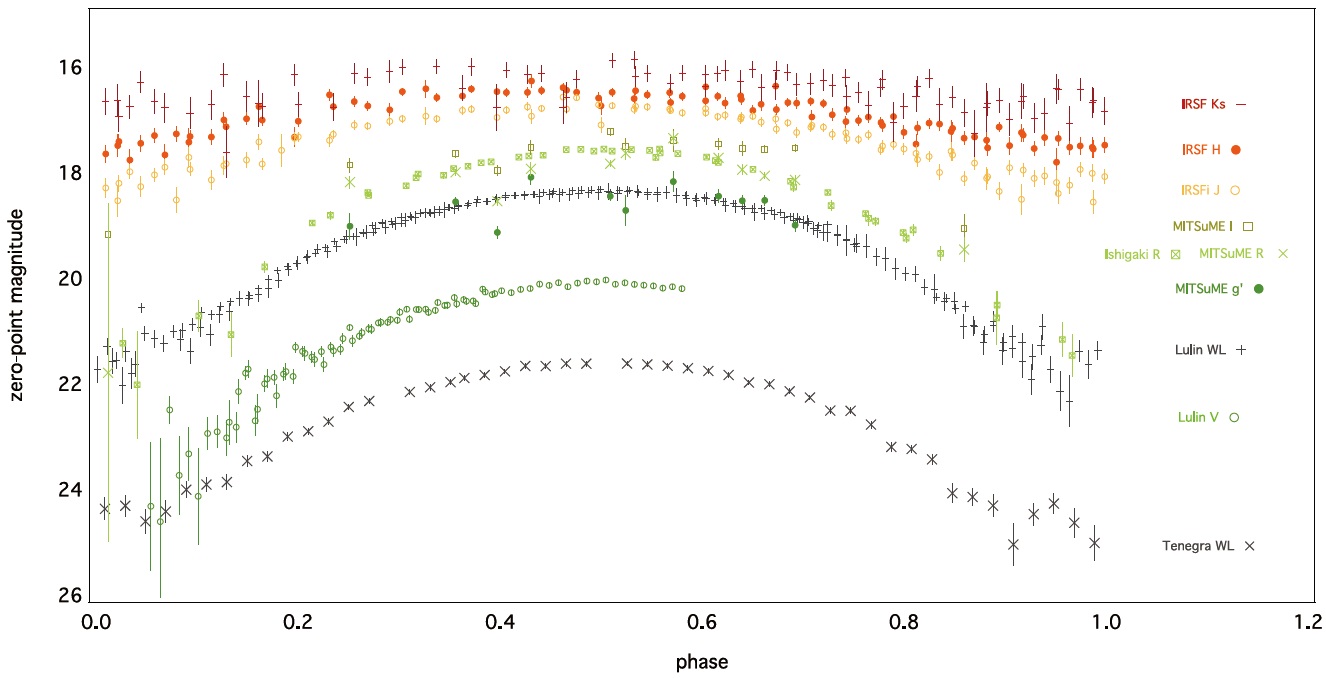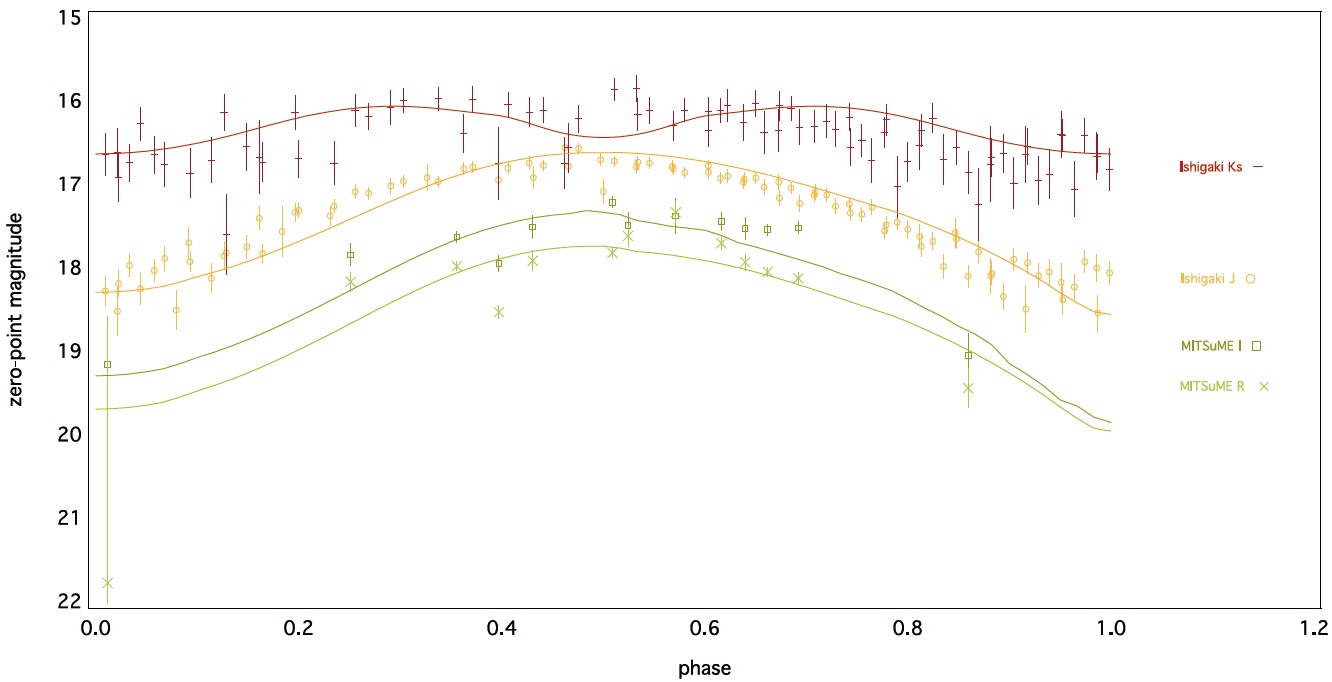The launch of the Large Area Telescope (LAT) onboard Fermi Gamma-ray Space Telescope (hereafter Fermi) and its Fermi LAT Second Source Catalog last updated in 2012 have revealed 1873 γ-ray point sources during its first 24 months of operation (Nolan et al. 2012). Amongst this second Fermi source catalog (2FGL), more than hundred γ-ray emitting pulsars were discovered or confirmed either by radio pulsation (Keith et al. 2011) or γ-ray pulsation (Pletsch et al. 2012a). Our target, 2FGL J2339.7-0531 was thought to be associated with a binary pulsar system (Romani & Shaw 2011, Kong et al. 2012), whose radio pulsation was later found at 2.88 ms with 820 MHz (Ray et al. in preparation).
One widely accepted version for the evolutionary scenario of fast-spinning millisecond pulsars (MSPs) is that an old neutron star has been spun up to a spin period on the order of millisecond via accretion from a companion which transferred mass and angular momentum to the pulsar. This process is usually dubbed ‘recycling’. Once the accretion has halted at some point, strongly magnetized relativistic pulsar wind will possibly carry away the pulsar rotational energy and angular momentum, meanwhile ablate and eventually evaporate its companion. The fact that the pulsar destroys what spins it up gave rise to the name ‘Black Widow’ pulsar. Our target, 2FGL J2339.7-0531, is a prototype of this sort. Studying such “near-death experience”' of these binary systems provides a wealth of information not only on the evolutionary history of isolated MSPs whose companion were gone but also on the physical details of the pulsars high energy emission properties. Multiwavelength identifications will also be of great help in understanding the radiative mechanism of such system. Up to now, all γ-ray emitting MSPs are radio loud- either they are associated with some previously discovered radio pulsar or found with follow-up radio survey. However, only one MSP (2FGL J1311. 7-3429) has been detected γ-ray pulsations with blind search (Pletsch et al. 2012b). Multicolor observations covering multiple binary orbits will greatly help in the determination of the emission geometry such as an estimate of inclination and thus the companion mass. Surface heating effect of the companion, temperature of various emitting regions, and pulsar wind density in the secondary Roche-lobe could be modeled, and an estimate of galactic extinction and therefore source distance could also be decided. All these will reduce the parameter space in searching pulsed detection in γ-ray, X-ray or radio wavelength, and help explain the detection (or non-detection) of pulsation in various wavelengths and the system characteristics in this specic phase of MSP evolutionary history.
In Kong et al. (2012), identification of lower energy counterpart of this γ-ray emitting MSP was reported to be at an astrometric postition of RA = 23h39m38s.7 Dec = 05°33'05''.0 using Chandra. Based on this Chandra position, we further searched for lower energy counterpart, and found a R ~ 19
star from the USNO catalog. We then carried out an intensive optical monitoring campaign first with the MITSuME 50 cm telescope located at Akeno Observatory in Japan from 55452.62629 to 55521.53568 MJD. MITSuME is equipped with a tricolor camera that can perform simultaneous imaging in the g', R, and I bands. After approximately 40 days, we followed-up this source with the One-meter Telescope at Lulin Observatory in Taiwan for two nights in a row for Johnson V band and white light respectively (55494.61923- 55495.67129 MJD and 55500.43791-55501.69024 MJD) for consecutive 2 minute exposures. This optical source was then observed a few days later in white light again with the 0.8 m Tenagra Telescope in Arizona (55511.07752-55511.26798 MJD) but this time for consecutive 5 minute exposures. Lastly, we used data from Infrared Survey Facility of South African Astronomical Observatory to obtain some infrared photometry for simultaneous J, H, and Ks band observation respectively (55833.75618-55835.07004 MJD). All images were corrected for bias and flat-field effects using standard IRAF procedures. We performed simple aperture relative photometry, taking into account several nearby comparison stars in the field, thus minimizing the influence imposed by various observing conditions, i.e. the seeing and clouds are grey. Observing conditions were variable; however, exposures are of high signal-to-noise ratio (S/N) even at optical minimum. We verify that the comparison stars are not variables by inspecting the relative count levels of these stars in all exposures, and reconstruct the apparent magnitude using standard stars in the field. After cautious inspection of these data, quasi-sinusoidally-modulated variation on a timescale of 4-5 hours in clearly seen. A period of 4.6343 hour is found in a Lomb-Scargle periodogram. If this modulation is orbital in origin, optical observations indeed greatly helped in providing an orbital timing solution and in improving the binary absolute phasing. All exposure midpoint were performed barycentric correction and the orbital residuals minimized to be plotted in a single orbital period. Here phase zero defines inferior conjunction (IC; approximately minimum light; the companion is in between the pulsar and observer). The complete light curve is shown in Fig. 1.
We make use of our photometric measurement to place constraints on the orbital parameters of 2FGL J2339.7-0531 by using the ELC code of Orosz & Hauschildt (2000). This code has the ability to model binary systems including treatment of accretion disk, reflection effect, with more variety in the ways one can specify the system geometry. This code also deals with the effect of companion illumination (‘X-ray heating’) and outputs modeled light curves. We are currently excluding white light measurement since the white light calibration for the zero point magnitude is not very accurate because all the catalogs use filters. We note that in a poster presentation of Schoeder et al. in the Fourth International Fermi Symposium (2012) for another black widow system 2FGL J2215.7+5135, the amplitude of
the modulation and peak intensity of their observations performed between 2010-2011 are both larger than our measurement performed in 2012. Similar feature was also observed for the optical counterpart of 1FGL J1311.7- 3429 which shows significant epoch to epoch variablity up to > 1 mag and 0.5 mag respectively over a span of two months (Kataoka et el. 2012). This might be an important implication that the system parameters change as the binary system evolves and we are actually witnessing the timeevolution of the stripping of the companion. We therefore propose to fit these lightcurves separately as different groups: first with observations in between 55450-55500 MJD, and then with those Ishigaki observations performed in between 55833.75618--55835.07004 MJD, in order to trace the system evolution. For the fits, we adjust the effective temperature (Teff) of the companion, the mass ratio (Q), and the inclination angle (i). The modeled light curves are over plotted on top of the observed light curves in Fig. 2.
Shown in Fig. 2 is the ELC modeling result of the two epochs. Comparing the fitted parameters of two epochs we suggest that the system switched from Teff = 5500 K to Teff = 5300 K, and from i = 68° to i = 65°. Although this may simply come from bootstrap, the best-fit parameters indicate an evolution of a mass ratio from Q = 2.4 to Q = 3.2. Assuming that the mass of the MSP is 1.4 M⊙ and using the mass function, we obtain a rough estimate for the minimum mass of the companion to evolve from 0.58 M⊙ to 0.43 M⊙, therefore suggesting a picture of companion evaporation. The smaller variation amplitude at longer wavelength may indicate that the infrared emission is thermal and originates from a region that is less eclipsed duing inferior conjuction. The infrared magnitude is too bright to be a typical latetype star, suggesting strong heating effect given this degree of enhancement. However, we place caution for the solidity of these fit values, as multiple minima exist. Additional photometric measurement and especially a precise pulsar mass function along with orbital ephemeris from radio observations will greatly constrain the parameter space for such a search and tighten up the fit considerably. Taking into account of the findings in Kong et al. (2012) (Fx/Fγ~ 0.01 consistent with typical observed values for γ-ray pulsars) we propose that 2FGL J2339.7-0531 is very likely an energetic γ-ray emitting MSP in orbit with a late type companion where the optical emission comes from the irradiation of the companion star while the pulsar is evaporating the companion in the late stages of recycling.





